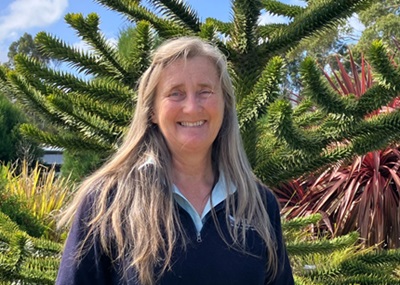Interview Recording
Interview Transcript
Tonia Cochran interviewed on 7 March 2024 by Jean Elder
Synopsis
Melbourne-born Dr. Tonia Cochran moved to Tasmania in the late 1980s while completing her Ph.D. in marine zoology. During that time she discovered Bruny Island, off the southeastern coast of Tasmania. Drawn to the island’s rich and diverse landscape, she found the idea of living there appealing.
Tonia settled at the foothills of Mt Mangana on South Bruny Island, transforming 1500 acres of pasture and bush into the Inala Nature Reserve, now a conservation-covenanted property. On a five-acre lot once used as a hay paddock, she began planting a garden with a Gondwanan theme.
Today Inala Jurassic Garden is a small, privately funded botanic garden that opened to the public in 2014. The garden features over 750 species from 50 family groups, showcasing Tasmanian endemic and rare plants and their connections to Gondwanan plant families.
Tonia maintains an active research profile worldwide, working with organisations including Bedgebury Pinetum, Kew Gardens, several Australian botanic gardens – the Global Conservation Consortiums for Nothofagus and Conifers, Wollemi Pine Metacollection Project and the Tropical Mountain Plant Science Project (TroMPS). These collaborations address issues such as ex-situ and in-situ conservation of threatened plant species, seed collection, propagation and plant disease.
The Inala Nature Foundation guides much of this work, while Inala Nature Tours provides essential funding. Though eco-tourism was not something Tonia initially expected to pursue, she now leads conservation-focussed tours to places such as Uganda and Bhutan, as well as throughout Australia. Locally, she is involved in a project protecting bird habitat on Bruny Island, particularly for the endangered Swift parrot and the Forty-spotted pardalote.
As a committed environmental scientist and ‘temporary’ land custodian, Tonia’s story highlights her work in conserving and promoting plant diversity and threatened species.
Read more about her work in ‘Saving ancient plants from extinction. Inala Jurassic Garden’s Noah’s Ark project’, Australian Garden History, vol. 34, no. 4, April 2023.


